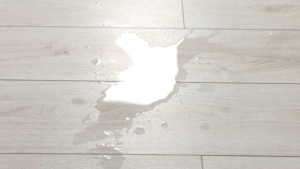Contact Our California Restoration Experts!
When people talk about window mold, they usually refer to window panes and sills. Accumulated dust, dirt, oil, and grease on window panes create the right environment for mold growth.
Window mold can be tough to detect, particularly when they match the window frame’s color. The same is applicable for window tracks as the mold blends in with other debris and dust particles.
Some Common Causes of Mold on Windows
Glasses of window panes are not organic, so the formation of mold is not possible. However, if you do not clean them regularly, mold can grow inside the window panes on particulates stuck to them.
The weather has a significant effect on the growth of mold on window sills and panes. During the cold weather, there is a temperature difference in outdoor and indoor air. So, the warm indoor air condenses and creates moisture that makes sills and trims damp and perfect for mold.
Incorrectly sealed windows allow additional moisture to enter through cracks and bring mold spores with dust and debris carried by the water. Window frames, whether it is aluminum or wood, can allow mold growth in suitable conditions.
Dust particles that accumulate in the joint between the glass and aluminum frames create perfect mold growth conditions. On the other hand, wooden frames work as organic substrates that can also provide food for molds.
If windows are not installed correctly, moisture and mold can build up, affecting wall sills, drywall, and wall cavities.
Steps to Remove Mold from Your Windows
One of the best ways to remove mold is by using disposable cleaning cloths. Paper towels and newspapers are good alternatives to fabric. You can follow these steps to clean mold off your windows:
- Step 1: Use a Concrobium spray to cover the entire window and let it dry for at least 5 minutes.
- Step 2: Now, use the spray a second time on the window. Take a paper towel or a newspaper to wipe down the window pane slowly. Try moving the towel in a downwards motion. This process will remove most of the mold and particles from the windowpane.
- Step 3: Use undiluted vinegar to clean the window again and wipe all the mold off.
One more way to clear the mold is using a mild detergent on the windows. Mix a cap full of bleach with warm water and scrub the windows using this mixture. Wear proper clothes while scrubbing off mold so that there is no contact with your skin. Try wearing masks or rubber gloves for extra protection. After the scrubbing, run a fan and/or open the windows for ventilation.
Prevent Mold Formation on Windows
Here are some additional tips to help keep the mold formation at bay.
➔ Painting the wooden sills with high gloss paints (after cleaning) can prevent mold growth (by lessening their ability to ‘stick’). Make it a habit to dust your windows sills, especially when you notice dampness.
➔ Try keeping the glass panes dust and dirt free. Use a humidifier that can control the humidity and reduce condensation.
➔ Clean the joints weekly where there are more chances of dust and moisture to accumulate.
➔ The aluminum tracks that control the opening and closing of windows are difficult to clean manually. So, use a narrow brush (like an old toothbrush) to dislodge the dust and then vacuum it up. First, remove the mold out of the tracks and then clear the dust.
➔ Add weekly window dusting to your housekeeping routine to help keep your windows free of mold. Installing humidifiers and shifting your indoor plants away from direct contact with windows will also help to stay clear of molds.
➔ If your windows are still getting condensed, try to dry them off quickly.
➔ Keep the shades open and ensure ample sunlight and airflow through the windows.
➔ If there are window weep holes, try to keep them debris and dust-free.
➔ Mold spore count increases during snow and rainstorms, so it is better to keep the windows closed in these situations.
➔ Try to maintain good airflow in the house to avoid humidity or condensation.
➔ Keep the thermostat above 70 degrees during the colder months.
➔ Beeswax is can serve as an alternative to mold-resistant paint for window sills.
➔ There are many sprays available in the market that can help prevent mold on windows. You can also take the help of a professional for selecting the products that clean window mold.
Facts That One Should Know About Mold
It is difficult to understand the seriousness of the situation unless you know what problem it can cause. If you think that window mold is a typical foe of homeowners, these facts will help you change your mind.
❖ Do you know the speed of mold growth? Mold can grow and spread within 24 to 48 hours in warm and wet conditions. So, whenever you detect mold on your windowpanes or sills, you need to start cleaning it quickly to avoid spreading.
❖ Houses with moisture in walls, under the floor, or in cabinets are a suitable breeding place for mold. It is usually not visible to naked eyes but can make you sick.
❖ Solving mold issues can be challenging on any budget, mostly if left untreated for a long time.
❖ If your body gets exposed to mold, you can face body aches, nausea, joint pain, and respiratory problems. You have to treat mold issues before symptoms grow and result in something severe.
❖ A person from young to adults can be affected by mold.
If you are planning on clearing the mold, do not forget to follow this protection guide:
- Wear a mask or respirator to filter mold spores.
- Ensure eye protection.
- Keep rubber gloves, scrub brush, and rags handy.
- Use non-ammonia detergent or soap and bleach.
- Nothing is better than a dehumidifier.
- Wear clothes or you don’t mind being affected by the chemicals you’re.
- Keep a garbage bag handy.
Contact Us
Are you looking for a water damage company in San Rafael? You can trust our experts for the best home inspections and mold removal services. Feel free to contact West Coast Fire and Water at (415) 417-0483 to get assistance for window mold problems.



